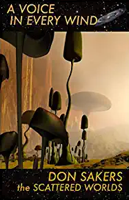Error message
- Deprecated function: The each() function is deprecated. This message will be suppressed on further calls in _menu_load_objects() (line 569 of /home2/dsakers/public_html/sw/includes/menu.inc).
- Deprecated function: implode(): Passing glue string after array is deprecated. Swap the parameters in drupal_get_feeds() (line 394 of /home2/dsakers/public_html/sw/includes/common.inc).
Newsletter Week of 3 July 2020
- A Voice in Every Wind (new trade paperback edition)
- The Rule of Five Quarterly #15
- The Rule of Five episode 2.22 now available for Patreon supporters
Although Shore Leave (an annual local con) has been canceled, they're still holding some events virtually—including the masquerade. As Masquerade Director, Thomas has been hard at work getting costumers to submit short videos, editing same, and co-ordinating the whole effort. We've both been very impressed by the quality of the entries, not just in terms of costume but also the technical quality.
All of which leads me to reflect on the phenomenon of amateur video.
We first started with amateur video in the 1990s, attempting (and failing) to produce a low-budget science fiction tv show. At the time, videotape was the state of the art. We spent about ten thousand dollars on equipment: high-end camcorders, an SVHS editing deck, and apparatus to turn our Amiga 2000 computer into a video studio. We learned about timebase correctors, interlacing, color correction, 3-D animation, and a dozen other esoteric subjects.
In the end, what we were trying was simply too ambitious for either the equipment or our abilities.
What a difference a few decades makes. Video is now digital; the tools are far cheaper and much more widespread. Anyone with a cellphone can record video in much higher resolution than we could; we can edit, add titles, and do simple special effects with apps that came free with our phones and computers. Not only is the ability to create quality video now available to almost everyone, it's also widespread and convenient.
There's no denying that the easy availability of digital video has changed the world in big ways and little, good ways and bad. YouTube, Instagram, Snapchat, TikTok, even Facebook are major building blocks of our society. Ask Black Lives Matter about the importance of amateur video in changing the world.
When all this started, companies like Apple and Commodore talked a lot about democratizing video production, empowering ordinary people with the tools to create quality video, liberating the creative sprit. They spoke of changing the world. Even then, it all sounded a little naive and hippie-ish. But damn if, two decades later, all that talk didn't come true!
- Scanned 6 more books
- Ripped 7 more DVDs to mp4
- The Rule of Five episode 2.22 posted for Patreon supporters
- Published The Rule of Five Quarterly #15 on Amazon
- Legion of Super-Heroes website: Working on old entries
- Added 400 words to my memoir
- Publoished new trade paperback of A Voice in Every Wind
- More work on the next gay erotic short story
- Great Kitchen Rearrangement: More clearing the kitchen table

Cover of the new trade paperback edition of A Voice in Every Wind.
Do you want to know the most difficult part of publishing a trade paperback book through Amazon (the new edition of A Voice in Every Wind, for example)? It isn't the actual book—I pulled the text from the most recent e-book edition, which has been repeatedly scrubbed to reduce the errors, and poured it into the page-layout format that I routinbely use for print books. It isn't the cover layout—I was able to use elements from previous print and e-book covers; in this case using the template that I use for all the Scattered Worlds books. It isn't the process of setting up the book, uploading files, and pricing—Amazon's online tools are easy to use. It isn't even the ISBN (International Standard Book Number)—many eyars ago I spent part of a big income tax refund on a hundred ISBNs, enough to last for decades more.
No, the most difficult part is getting the spine text properly sized and positoned. Amazon's tolerances for such things are much, much tighter than Lightning Source, my previous printer. Since A Voice in Every Wind (like Weaving the Web of Days and Elevenses) is a particularly short book, the spine is particularly narrow. Amazon provides an interface that draws helpful dashed lines to indicate boundaries—but the resolution isn't set up for narrow spines. With all three of these titles, it's been a guessing game: place the spine text, submit the cover, and then wait a day or so to find out that it's not positioned correctly. Move/shrink the text, guess again, and repeat.
I was somewhat lucky this time around: it only took three rounds to get a passing design. Elevenses, I think, took seven.
At least it doesn't cost anything to play this game. When I worked through Lightning Source, each revision of the cover cost something like $50 to submit...even if it got rejected. Amazon, happily, doesn't charge for revisions.
In any case, the new edition of A Voice in Every Wind is done and available. Take a look.
"When you think of the long and gloomy history of man, you will find more hideous crimes have been committed in the name of obedience than have ever been committed in the name of rebellion."
-C.P. Snow
Apple: for their products, their customer service, their data ecosystem...and for the undeniable dents they've made in the universe.
